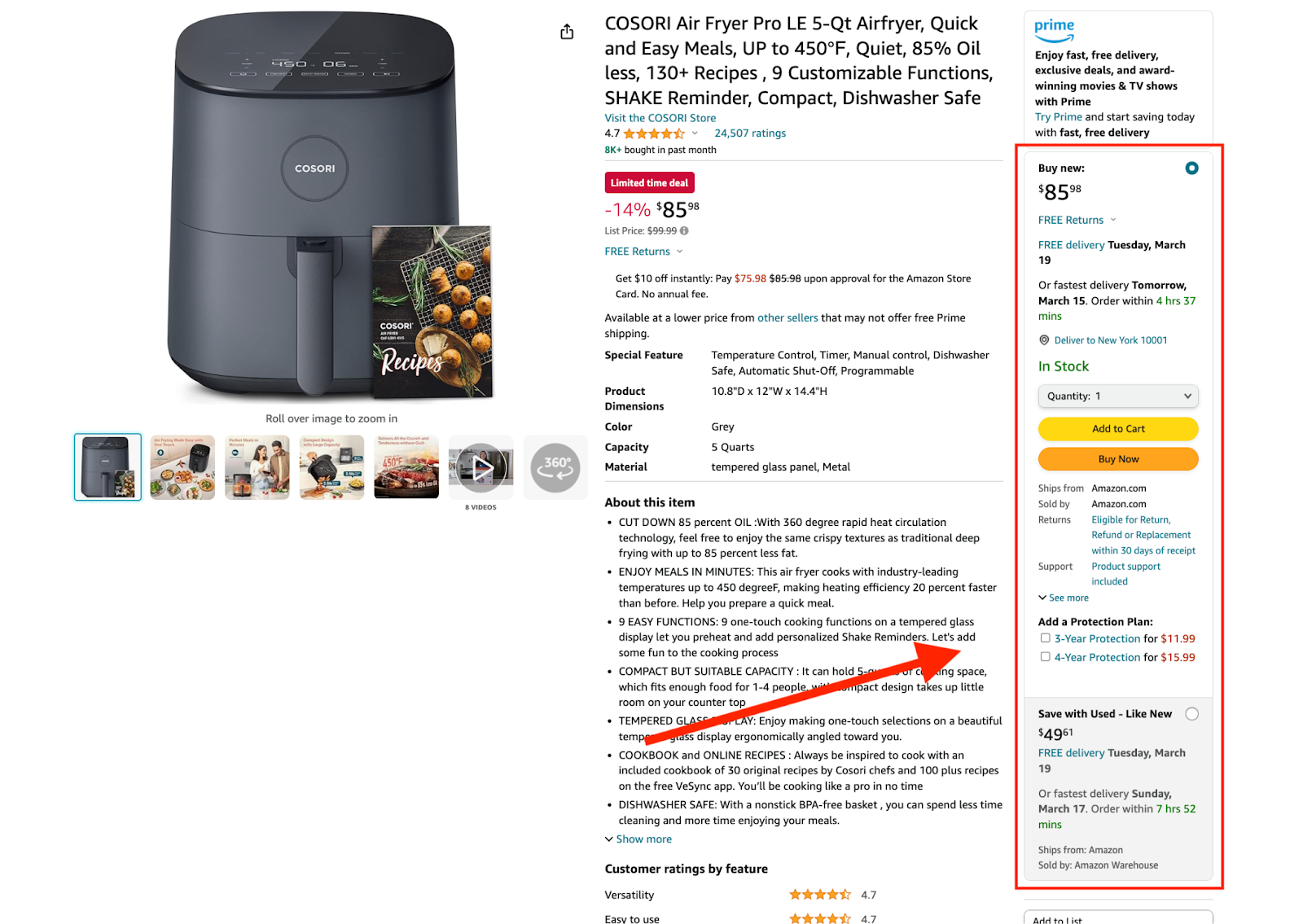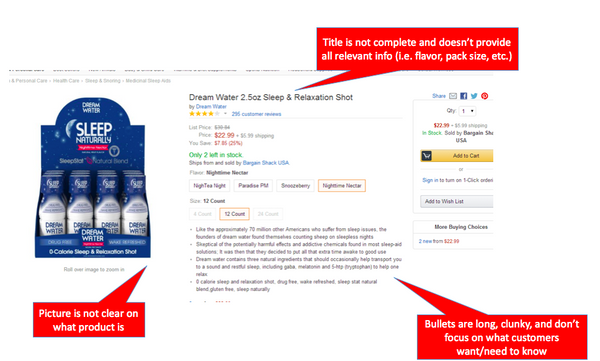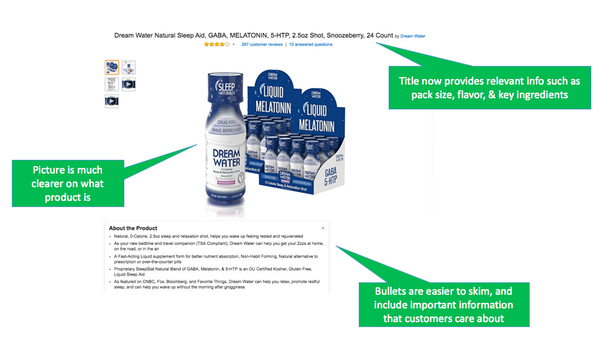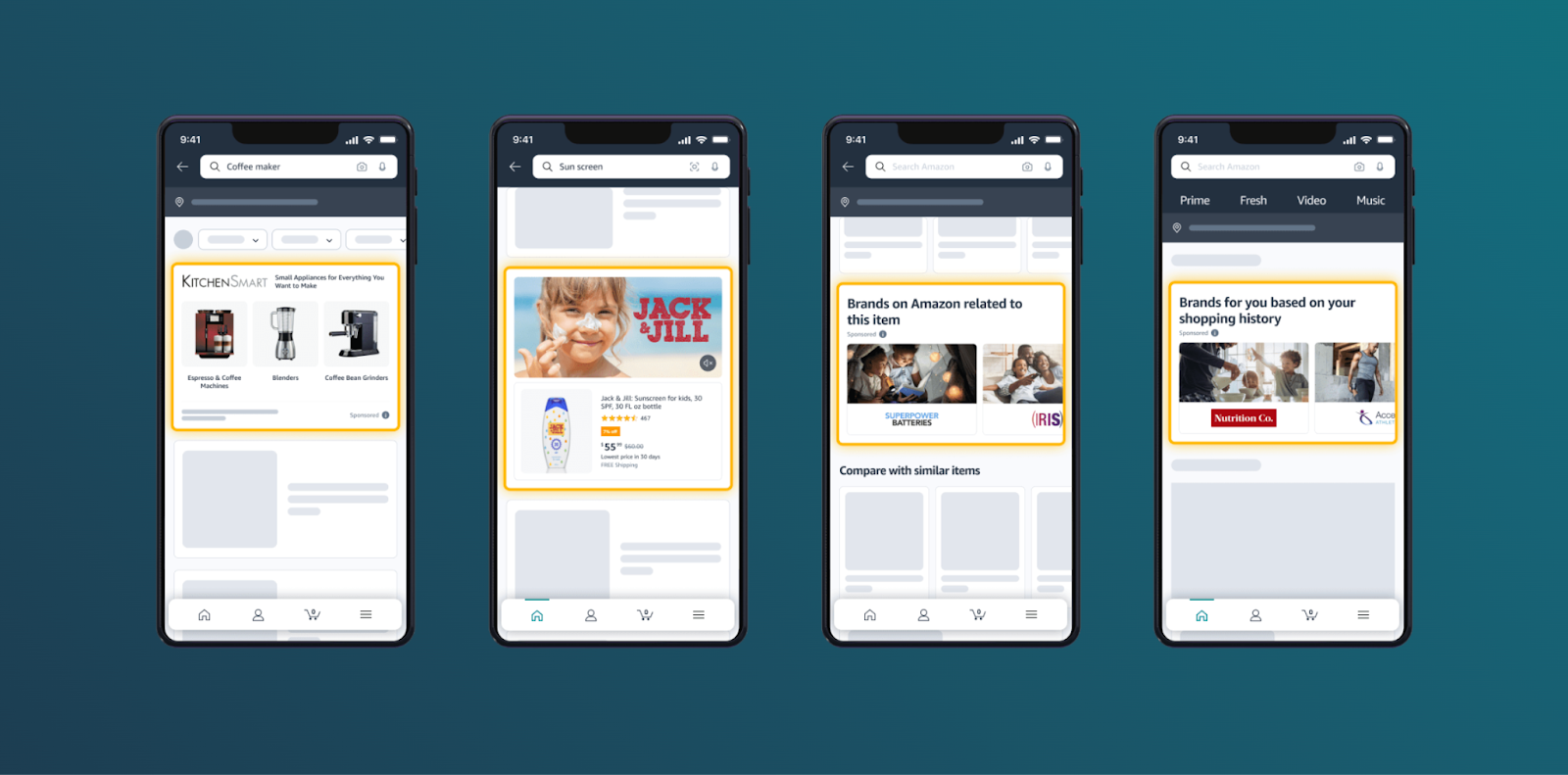Did you know that half of online shoppers start their search for a product on Amazon?
As the internet’s most popular shopping destination, it makes sense for your business to appear on Amazon. But how do you stand out and attract customers on competitive Amazon results pages when opportunities for promotion are limited?
By learning how to promote your products on Amazon, you can gain exposure for your brand while building a funnel of potential customers toward your ecommerce website.
Sell on Amazon with Shopify
Simplify multichannel selling by connecting your online store to marketplaces, including Amazon. Sell and manage products, fulfill orders, and track performance across Amazon, Walmart, eBay, Etsy, and your ecommerce website—all from your Shopify admin.
Learn more9 ways to promote your Amazon products
Once you’re up and running on Amazon, it’s time to start promoting your listings. Like any other sales channel, it’s important to try out different marketing methods, monitor results, and adjust your marketing strategy accordingly.
Here are nine ways to promote your Amazon store to drive more sales.
- Run a competitor analysis
- Get your pricing right
- Use titles and images to enhance search rankings
- Fine-tune product descriptions to convert customers
- Sync your Shopify store with Amazon
- Encourage more reviews
- Run sponsored product ads
- Register your brand
- Leverage social media influencers
1. Run a competitor analysis
The first step to promoting your products on Amazon is understanding what you’re up against.
You can learn a lot about your existing customers and competitors by studying product pages. You’re also more likely to spot new promotional opportunities by periodically reviewing competitors.
Try these simple competitor analysis methods:
Read competitor reviews
Think of Amazon reviews as a town square for customer insights—a place where customers freely express their thoughts about a product. Look for patterns in both positive and negative reviews, focusing on frequently mentioned product features.
When a feature that your product shares gets rave reviews on a competitor page, make sure to highlight that feature in your product descriptions. On the other hand, if a feature is consistently criticized in competitor reviews and your product doesn’t have it, that’s a selling point. Make it clear to customers that your product excels where others fall short.
Monitor page freshness
Your competitors are fine-tuning their Amazon product listings, just like you. Their pages aren’t static, so it’s a good idea to maintain a spreadsheet to track competitor updates. What exactly are they changing—is it the product content, images, or pricing?
Competitors may switch product photos to match the season, or rewrite product use cases in response to popular trends. Try to identify patterns between these changes and any shifts in popularity. This can help you decide whether you should revisit your own product pages. For instance, if you notice a competitor runs out of stock, it might be an opportune moment for you to adjust your pricing or ramp up your ads.
Research related products
Don’t forget to follow products and brands in adjacent product categories. There may be chances for cross-selling. For instance, a memory card brand and a camera store could mutually benefit from sharing audiences.
Even if you don’t enter into official partnerships, you may find additional opportunities to promote your products to similar audiences.
2. Get your pricing right
Product pricing is the most direct way to gain a competitive advantage on Amazon. While you don’t necessarily need to be the cheapest product in your category, you do need to convince shoppers that you offer the best value for money.
Bear these things in mind when developing your Amazon pricing strategy:
Automate prices to win the Featured Offer
The Featured Offer (formerly Buy Box) section is found in the top right of most product pages. It’s where customers can directly add items to their shopping carts. Sellers listing the same product can compete for this prime real estate, hoping to be selected by Amazon and shown to shoppers above competitors.
To win the Featured Offer, try using Amazon’s automate pricing tool to dynamically adjust your prices and remain among the best offers for your category. For example, you can set a rule to “beat the lowest Fulfilled by Amazon price by 10¢” so that you appear regularly. The tool will also alert you when prices change.
Use discounts strategically
Discount promotions are an effective way to increase your product’s visibility when you’re not ranking among the top results. When eligible, Amazon will invite you to set up limited-time deals. You can also offer coupons to highlight your products on category pages.
Mind Amazon’s Fair Pricing Policy
Amazon has a Fair Pricing Policy that encourages sellers to set reasonable prices and maintain customer trust. This policy discourages practices such as setting misleading reference prices, pricing products significantly higher than recent prices, or adding excessive shipping fees. Follow the policy and make sure your pricing strategies aren’t at the expense of your customers.

3. Use titles and images to enhance search rankings
To make your Amazon product listings more visible in search results (on Amazon.com and on Google), you’ll need to get strategic with your product titles, descriptions, and images. Try these tactics:
Apply keywords in titles
Incorporate relevant keywords into your product titles and descriptions to signal that your products are relevant to customer searches. Choose keywords that are popular with your customers and accurately reflect your product’s features.
Ensure product titles meet these criteria to improve search engine optimization and the chances of appearing in search results:
- Clearly describes the item to customers
- Outlines any variants or specifications
- Includes the brand name
- Highlights the product use case or primary benefit
- Make sure title is shorter than Amazon’s limit of 200 characters
Showcase high-quality photos
Your main product image should clearly depict the product without needing to zoom or pan. Additional images can offer different angles or lifestyle shots. Consider including an image of the product’s packaging to show ingredients and instructions.
You can use Amazon’s Manage Your Experiments tool to run A/B tests on your titles and images. The feature lets you compare two versions of a product listing with different title variations or photos to identify what resonates more with customers.

4. Fine-tune product descriptions to convert customers
To turn browsers into buyers, craft compelling bullet points and product descriptions. Again, regular testing can help you pinpoint what works best.
Keep bullet points direct
Bullet points should answer key customer questions and highlight essential facts, such as:
- How a product solves a consumer need
- Why a product is the best solution for a consumer’s need
- The range of product variants
- Additional benefits, such as a product warranty
Make sure to hit all of the key questions that customers need answered so they don’t have to scroll below the fold.
Tell a story through product descriptions
Product descriptions should be clear and informative. Use your brand voice to reiterate key selling points and mention any supporting facts that encourage immediate purchase. Keep your descriptions concise and easy to read.
Remember that customers are skimming, so a 10-line long paragraph probably won’t do the job. Use your brand voice here and reiterate key selling points while mentioning any supporting facts that can help customers understand why they need to buy now.

5. Sync your Shopify store with Amazon
Shopify’s Marketplace Connect app links your online store and Amazon product pages, providing you with a broader audience and greater potential for sales.
Use the app to update product details, adjust pricing, or tweak descriptions without having to switch between platforms. You can also customize your Amazon listings in bulk. Edit product attributes in batches to better fit Amazon customers’ search habits and preferences.
Connecting your various ecommerce sales channels through Shopify also ensures your product availability information is always up to date, reducing situations where an out-of-stock product is listed for sale on Amazon.
Using Shopify’s analytics tools, you can track which products are performing well, identify trends, and adjust your promotional and marketing strategies accordingly.
6. Encourage more reviews
Customer reviews are a primary online source of social proof, helping shoppers feel more confident about purchasing a product. Earning quality Amazon reviews can also influence sales on other channels, like your online store, as customers may get their first impression of you from the marketplace.
Sign up for the Amazon Vine Program
The Amazon Vine Program invites experienced Amazon reviewers to test out selected products and post extensive reviews. Reviewers who have earned the title of Vine Voices request products they want to review, try them for free, then share their honest opinions.
Enrolling in Vine can increase your product’s visibility and encourage other customers to leave reviews. Check whether you’re eligible for the program.
Send follow-up emails
Amazon allows sellers to send post-purchase emails to customers about their orders. You can send a series of emails confirming the order and asking for feedback on the product and service.
Consider sending two emails: one to confirm receipt or shipment of the order, and another a few weeks after the customer has received their product to encourage them to post a review. Keep the tone friendly and provide an opportunity for customers to share any negative feedback privately before writing a review.
Automation tools like FeedbackFive and Seller Labs can help you automate customer emails. Larger sellers may benefit from using a customer communications tool so complaints and valuable feedback aren’t missed.
7. Run sponsored product ads
If organic strategies aren’t helping, try a paid ad campaign. Amazon’s ad platform has a variety of options for promoting your products directly to Amazon customers. Ads on desktop can appear above, alongside, or below search results, as well as on product detail pages.
Amazon ad types include Sponsored Product ads, Sponsored Brand ads, and Sponsored Display ads.
Sponsored Products
Sponsored Products are pay-per-click ads that promote individual products on results pages and product detail pages. You can target specific search terms or allow Amazon to automatically match your product with customer searches. According to Amazon, sellers see an average 50% increase in weekly orders within a year of launching a Sponsored Products campaign.
Sponsored Brands
Sponsored Brands ads are similar to Sponsored Products but offer a way for sellers to serve richer brand content to relevant audiences. These ads can include videos or multiple products and cover the entire width of the screen.
You’ll need to be enrolled in Amazon’s Brand Registry to run Sponsored Brand ads (see the next section).
Sponsored Display
Sponsored Display campaigns reach customers on Amazon, other websites, and apps. They use rich media and contextual signals to appeal to relevant audiences rather than targeting specific keywords.

8. Register your brand
If you have a brand, enrolling it with Amazon’s Brand Registry gives you access to enhanced marketing tools that protect you against fraudulent use of your logo and name.
After joining the registry, you can report anyone misusing your brand, stopping problem listings before they confuse your customers.
The brand registry also lets you manage content and photos on detail pages, so customers experience consistent, up-to-date information about your products, wherever they’re listed. You can use the dashboard to keep track of stats and understand where your brand is appearing on the platform.
Brands need a registered or pending trademark to be eligible for the Amazon Brand Registry.
9. Leverage social media influencers
Partnering with social media influencers can be a powerful way to promote your Amazon products. Influencers have built-in audiences and know how to generate views on YouTube, TikTok, and Instagram.
Find and connect with influencers
Find influencers who align with your brand and have a following that matches your target audience. Identify relevant accounts by searching for hashtags and keywords—or by choosing an influencer from Shopify Collabs. Reach out to them directly, usually through a private message or email, to express your interest in collaborating.
Build a partnership
In a partnership, the influencer promotes your product to their audience. In return, you might offer free products, payment, or an affiliate commission on sales made through their unique Amazon affiliate link below. Make sure to discuss expectations, like how and when the product will be promoted.
Offer affiliate commission
Even without a direct partnership, you can still benefit from social media promotion through the Amazon affiliate program. Bloggers, vloggers, and other kinds of influencers who meet Amazon’s eligibility criteria for the affiliate program can earn a small percentage of sales revenue by referring your customers.

Promote your products for more sales on Amazon
Selling on Amazon Marketplace is competitive, complex, and sometimes frustrating. But with the right promotional strategy, you can make sure your Amazon product listings are in a better position to compete.
If in doubt, focus on meeting the basic criteria of a trustworthy Amazon seller: clear images, factual descriptions, competitive pricing, and high-quality reviews.
Promote products on Amazon FAQ
How do you promote products on Amazon?
- Run a competitor analysis.
- Adjust your pricing.
- Optimize titles and images to improve search rankings.
- Optimize bullet points and descriptions to increase conversions.
- Manage your Amazon listings through Shopify.
- Encourage customer reviews.
- Run sponsored ads.
- Join the Amazon Brand Registry.
- Partner with social media influencers.
How much does it cost to promote an item on Amazon?
What does visibility mean for Amazon products?
What’s the difference between internal and external promotions on Amazon?
Topics:
Join 446,005 entrepreneurs who already have a head start.
Get free online marketing tips and resources delivered directly to your inbox.
Thanks for subscribing
You’ll start receiving free tips and resources soon. In the meantime, start building your store with a free 14-day trial of Shopify.





